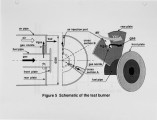| OCR Text |
Show Figure 11 shows the distribution of CO concentration. A sharp increase in CO is observed at roughly 400 mm downstream of the burner, which corresponds to the ignition point of the lifted flame. CO then starts decreasing at 600 mm with its oxidization almost completed at 800 mm downstream. This indicates that the fuel gas mixes with the combustion air to a certain extent before the ignition. Along with the flame photographs, the CO distribution gives clear evidence of the lifted flame. Figure 12 shows the distribution of CO2 concentration. Both the internal and external recirculation zones show relatively high CO2 concentration, nearly equal to that of the exhaust gas. This indicates that the recirculation zones are filled with the combustion products or the flue gas. The recirculated flue gas eventually entrains into the main forward flow. As the mixing of the combustion air and fuel gas proceeds, flue gas is entrained effectively before the ignition, thereby enhancing the self-induced flue gas recirculation. The two large recirculation zones contribute greatly to the entrainment of a large quantity of flue gas. The internal recirculation zone, in particular, recirculates relatively high temperature flue gas, thereby helping to ignite the lifted flame. Figure 13 shows the distribution of NOx concentration. Considering the entrainment of combustion product, the flame produces virtually no N Ox before it reaches 400 mm downstream. After ignition NOx gradually increases, with a maximum concentration of less than 15 ppm. As previously shown by the CO2 concentration, the effect of self-induced EG R appears to be maximized. 4.5 Degree of self-induced flue gas recirculation Once the flame is lifted, NOx level decreases drastically. The distributions of gas species concentration indicate the substantial contribution of the enhanced self-induced EGR to the low N Ox emission. By analyzing the concentration of gas species, the degree of selfinduced EG R can be evaluated. Figure 14 shows the distnbution of local excess air ratio A'. Local excess air ratio A' is calculated from the distribution of dry-based measured gas species. By evaluating H20 |























